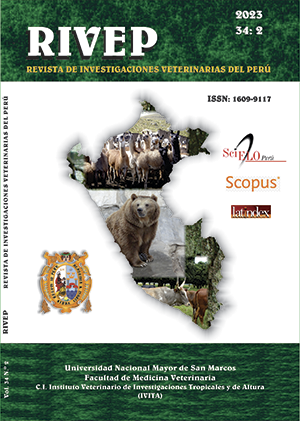Counting of fungi and detection of mycotoxins in feed supplies and balanced feeds in pig farms in the province of Coronel Portillo, Ucayali, Peru
DOI:
https://doi.org/10.15381/rivep.v34i2.25098Keywords:
pig farms, food, fungi, mycotoxins, Peruvian AmazonAbstract
The aim of this study was to perform a fungal count and detect mycotoxins in feed supplies and balanced feed from pig farms in four districts of Coronel Portillo, Ucayali. Fifty samples were collected (35 of balances feeds [three rearing stages] from 20 farms and 15 of feed supplies from 10 of these farms). The fungal count was performed using the plate count method and the detection of mycotoxins (aflatoxin B1, ochratoxin A and zearalenone) using commercial ELISA kits. Results showed that 50% of farms had at least one sample of unacceptable quality. Likewise, 6/15 (40%) and 5/35 (14.3%) of feed supplies and balanced feed samples, respectively, had unacceptable quality. The starter feed had the highest average fungal count (9.6 x 104 CFU/g). There was an association between quality and type of food, but none between quality and origin. Half of the farms had at least one feed sample with mycotoxins above the Maximum Permissible Level (MPL) and 42.9% (15/35) of the samples had at least one mycotoxin above the MPL. The highest mean for aflatoxin B1 was found in the starter feed (26.2 ppb) and the highest for zearalenone in breeders feed (74.5 ppb).
Downloads
Downloads
Published
Issue
Section
License
Copyright (c) 2023 David Huatuco C., Juan Rondón E., Lluvis Germany G., César M. Gavidia, Luis Luna E., Raúl Rosadio A.

This work is licensed under a Creative Commons Attribution 4.0 International License.
AUTHORS RETAIN THEIR RIGHTS:
a. Authors retain their trade mark rights and patent, and also on any process or procedure described in the article.
b. Authors retain their right to share, copy, distribute, perform and publicly communicate their article (eg, to place their article in an institutional repository or publish it in a book), with an acknowledgment of its initial publication in the Revista de Investigaciones Veterinarias del Perú (RIVEP).
c. Authors retain theirs right to make a subsequent publication of their work, to use the article or any part thereof (eg a compilation of his papers, lecture notes, thesis, or a book), always indicating the source of publication (the originator of the work, journal, volume, number and date).



